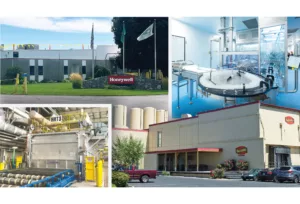Avista subsidiary Salix is in line to build fuel facility in Alaska
Liquefied natural gas plant would serve state's interior

The Alaska Industrial Development and Export Authority has ranked a proposal submitted by Spokane-based Salix Inc., a subsidiary of Avista Corp., at the top of a list of 13 companies vying to liquefy natural gas for delivery to customers in the interior part of that state.
According to Salix’s initial proposal, the Alaska corporation would pay the Spokane company $40 million over 20 years in exchange for a $10 million investment and plant operation. Once up and running, Salix would generate and sell liquefied natural gas that would then be trucked to inland Alaskan communities.
Salix’s proposal was ranked ahead of that of Oklahoma-based Spectrum LLC, which seeks $54 million in payments over 20 years in exchange for a $5 million investment and plant operations, according to its response to the request for proposals.
Salix’s proposal also calls for plant ownership to revert to two different Alaska utility companies after 30 years.
Salix President Robert J. Lafferty says the company is encouraged to have been ranked at the top of the list by the Alaska export authority.
Lafferty, who worked for Avista for 30 years before being named Salix’s president almost two years ago, says, “This is just the kind of opportunity in the market we were seeking for Salix when it was created, and we’re optimistic there will be more opportunities like this as we move forward.”
Lafferty declines to offer more specifics because negotiations are still taking place.
The Alaska export authority was created in 1967 by the Alaska Legislature for development of its natural resources through the establishment and expansion of manufacturing, industrial, energy, export, small business and business enterprises, says the AIDEA website.
A selection committee voted 7-0 in favor of Salix’s proposal to develop what is called a liquefaction gas plant.
“Salix was perceived as a partner more willing to adapt their project/approach to meet utility/project needs,” the Alaska export authority writes in its decision to rank Salix over Spectrum.
Karsten Rodvik, a spokesman for the Alaska export authority, says a specific time frame to build the plant hasn’t been finalized.
Despite the ranking, Avista spokeswoman Jesse Wuerst says the Alaska export authority still could select a competing proposal.
The liquefied natural gas (LNG) plant would be located in the area of the Cook Inlet in South Central Alaska, Wuerst says.
She says Salix continues to explore other development opportunities, but she declines to reveal other projects Salix is pursuing.
Avista formed Salix to explore domestic markets, specifically wholesale and business-to-business customers in the western U.S., for liquefied natural gas. The LNG is converted from its gaseous state to take up less space so it becomes easier to transport and store, Wuerst says.
Under the direction of Alaska Gov. Bill Walker and that state’s Legislature, officials there in recent years have been exploring ways to reduce home heating costs for residents of Alaska’s interior who rely mainly on oil to heat homes and businesses, she says.
The Alaska export authority issued a request for proposals for a LNG facility last June, and Salix was one of 13 companies to submit proposals, Wuerst says.
“Nothing has been finalized as of yet,” Wuerst says. “We are still in negotiations with AIDEA and there are still many steps left to go in this process. It has been an evolving project.”
However, Wuerst says, a global decline in crude oil prices has diminished the sense of urgency among Alaska lawmakers for the immediate development of the LNG plant.
Salix was established when global oil prices were above $100 per barrel. Since then, prices have dipped as low as $30 per barrel, although they recently have been trending upward again, this month cresting the still comparatively low $40 mark.
“It doesn’t wipe out their need to have liquefaction plant facility, but the immediacy isn’t as strong as it was when prices were higher,” Wuerst says.
“We’ve been doing natural gas since 1958, which was one of the reasons we think AIEDA ranked us at the top of the list,” she adds.
Avista Utilities currently provides electric service to 366,000 customers and natural gas to 326,000 customers in Eastern Washington, North Idaho and Eastern Oregon.
The Center for Energy Economics based in Houston says the process of liquefying natural gas dates back to the 19th century in Europe. The first LNG plant was built in West Virginia in 1912 and began operation in 1917.
LNG involves cooling the gas to minus 260 degrees Fahrenheit, the point at which gas condenses to a liquid. The liquefaction process reduces the volume of natural gas 600 times—similar to reducing the volume of a beach ball to the volume of a ping-pong ball—Salix says on its website.
LNG is then stored and transported at a low pressure in double-walled, insulated tanks. The inner tank contains the LNG, while the outer tank contains insulation and prevents any natural gas vapor from escaping. Once delivered to its destination, the LNG is then warmed back into its original gaseous state so it can be transported via pipeline to its final destination for distribution to homes and businesses, says Salix’s website.
LNG is not explosive in liquid state, the website says, and when it’s heated and becomes a gas, the gas isn’t explosive if it’s not confined.
Wuerst says Alaska is the only state in the union that allows LNG to be transported by rail due to the lack of road access to many communities in interior Alaska. LNG is typically transported by truck in the 48 contiguous states.
Related Articles

_c.webp?t=1763626051)
_web.webp?t=1764835652)

